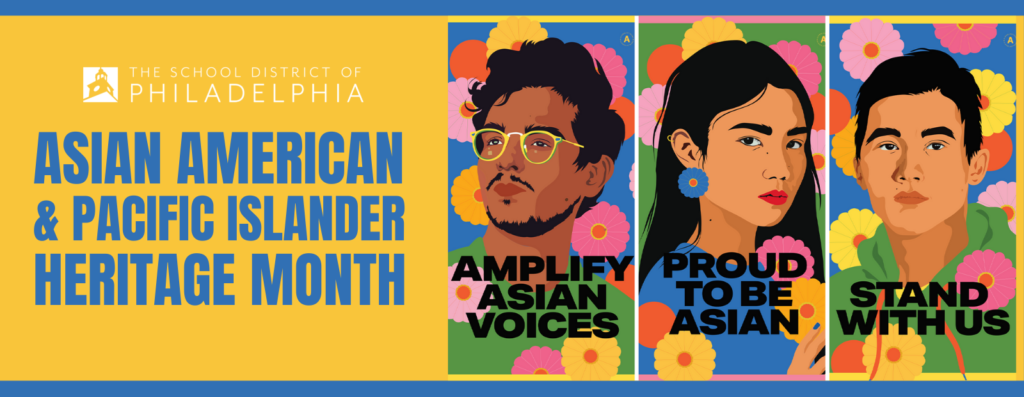Reflections on Asian American Pacific Islander (AAPI)History Month – Make Us Visible
By Deborah Wei, Social Studies Curriculum Specialist, Office of Curriculum and Instruction
AAPI stands for Asian American and Pacific Islander. The term is used to describe a diverse and growing population of 23 million Americans that include roughly 50 ethnic groups with roots in more than 40 countries. It is a term encompassing a geographic territory. Pacific Islander history is not one of immigration to the US, but of conquest of the land and people of the islands. As indigenous people, they have always been “home.”
Pacific Islanders are the peoples of the Pacific Islands. As an ethnic/racial term, it is used to describe the original peoples of Melanesia, Micronesia, and Polynesia. The particular experiences of Pacific Islanders are distinct and I have not addressed that in this article, but the Office of Curriculum and Instruction resource guide for AAPI History Month includes resources for teaching about the history of Pacific Islanders.
Some people call this Asian American Pacific Islander Heritage Month. But I call it Asian American Pacific Islander History Month because history matters. There is a long history of Asians in America (the first documented arrivals on the continental U.S. were a group of Filiopinos in 1587 in what is now Morro Bay, California.) And yet, the history of Asian America remains largely invisible. Without knowledge of history in this country, Asian Americans are often seen as not really American – relegated to the role of perpetual foreigner.
Asian American history is a history of the human spirit, a history including landmark Supreme Court cases, invention and discovery, artistic achievement, athleticism, heroism, courage, alliance, and above all, hope. As you read more about the people on the posters sent to every school building this month, the breadth of our experience can be seen in the stories of the incredible people featured. We are thrilled to provide information and resources that help the Asian American Pacific Islander historical narrative become more visible in Philadelphia.
But, as with all historical recounts, there is also a “hard history” – a history that continues through today. Just a month ago, I heard it again. “Chinese. Go back to your country. Get the f… out.” Anti-Asian violence comes in many forms, even in this city I have called home my whole life.
The current prevalence of anti-Asian violence is fueled by politics and the never ending need to find scapegoats for a whole host of ills – inflation, war, pandemics, unemployment. The hate follows a long history of the unique position of Asian Americans in the United States as perpetual foreigners. The consistent message has been: “You don’t belong here.”
Asian hate was operating when:
- The US passed the Naturalization Act of 1790 – a bill that limited access to US citizenship for immigrants to white immigrants;
- In 1863, the California Legislature passed a statute prohibiting Asian Americans from testifying in court against white people as witnesses or victims, and led to a popular phrase “not a Chinaman’s chance” – meaning no chance for protection from violence;
- In 1871, 15 Chinese were lynched (19 died altogether, many more were beaten and mutilated) by a white mob in Los Angeles;
- The Chinese Exclusion Act was passed in 1882, denying Asians the right to immigrate – even as sojourners – therefore prohibiting family unification. The act was not fully lifted until 1965;
- On September 2, 1885 , white rioters in Rock Springs Wyoming murdered at least 28 Chinese miners, and burned down 78 Chinese homes;
- From 1942-1946, 120,000 Japanese Americans, more than half of them children, were forcibly removed from their homes and incarcerated;
- In 1981, Ku Klux Klan members attacked and set fire to Vietnamese shrimping boats in Texas;
- In 1981, the two white men who beat Chinese American Vincent Chin to death with baseball bats in Detroit were fined $3000 as “punishment” for the crime;
- On September 15, 2001, when Balbir Singh Sodhi, a Sikh American gas station owner was murdered by aircraft mechanic Frank Silva Roque who said Balbir was a “terrorist”;
- In 2006, a Chinese immigrant parent in Philadelphia who informed ICE agents she was pregnant with twins, was physically thrown into a van causing her to lose her babies;
From March 19, 2020 to December 31, 2021, a total of 10,905 hate incidents against Asian American and Pacific Islander (AAPI) persons were reported to the organization Stop AAPI Hate.
Affirming Asian American historical presence and the long, ongoing struggle for civil and human rights as Americans is what we celebrate this month. Yes, AAPI heritage is worth celebrating too. Our food, fashion, folk tales, festivals, and famous people matter as well. But it is the history that remains invisible. Using May to lift up that history for even a brief moment helps to fight invisibility. I am grateful that the School District is offering these resources to help Asian Americans affirm our right to say “We belong here.”
Notes
The term, “Asian American,” was coined by activists in 1968. Its creation was the direct result of radical cross-racial and ethnic solidarity movement building in the US in the 1960s. It was a repudiation of the term “Oriental” and a direct response to white supremacy. The term helped very disparate people in the US recognize that once here, shared histories and experiences tied very different ethnic groups together. “Asian American” was created to promote unity and to advance the fight for collective liberation for all people of Asian descent in the US. As such, the roots of the term “Asian American” are firmly placed in a radical tradition.

Recent Comments